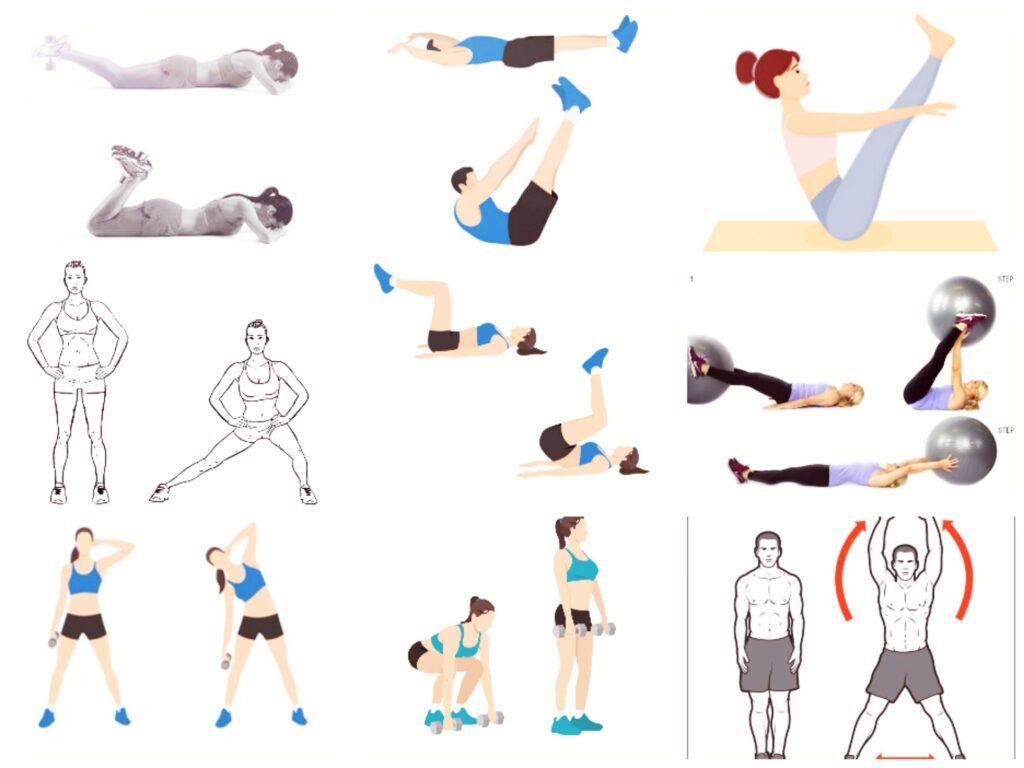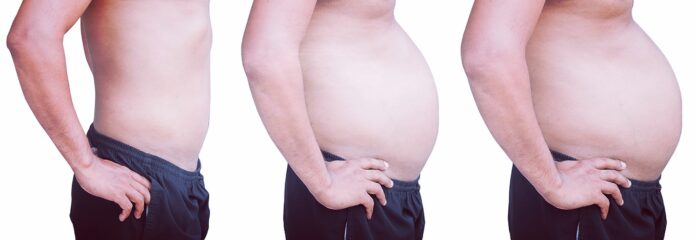
Belly Fat Reduction Tips: the root cause of belly fat and how to reduce belly fat
Belly fat, also known as visceral fat, is the excess fat that accumulates around the abdomen and internal organs. It is a major concern for many people, as it not only affects their appearance but also increases the risk of developing various health problems, such as diabetes, heart disease, and cancer. In this article, we will discuss the root cause of belly fat and how to reduce it. Root Causes of Belly Fat included:
Poor Diet: Poor diet is one of the primary causes of belly fat. Consuming a diet high in processed foods, refined carbohydrates, and added sugars can lead to the accumulation of belly fat. Such foods are low in nutrients and high in calories, leading to weight gain and abdominal fat.
Lack of Exercise: Lack of physical activity is another root cause of belly fat. A sedentary lifestyle contributes to the accumulation of visceral fat. When we don’t move our bodies enough, our muscles become weak and lose their ability to burn calories efficiently. This slows down the metabolism and leads to weight gain.
Genetics: Genetics can also play a role in the accumulation of belly fat. Some people are more predisposed to gain weight around the abdomen due to their genetic makeup. However, genetics alone cannot be blamed for belly fat, as lifestyle factors such as diet and exercise also play a significant role.
Stress: Chronic stress can also contribute to the accumulation of belly fat. When we are stressed, our body releases cortisol, a hormone that increases appetite and promotes the storage of fat around the abdomen. This is because cortisol triggers the release of insulin, which in turn promotes the storage of fat.
Age: As we age, our metabolism slows down, and we tend to lose muscle mass. This can lead to an increase in belly fat, as our body’s ability to burn calories decreases.
Hormones: Hormonal changes can also lead to the accumulation of belly fat. For instance, women tend to gain weight around the abdomen during menopause due to a decrease in estrogen levels. Similarly, men with low testosterone levels may also experience an increase in belly fat.
Exercise for reducing belly fat: To work these exercises, it’s important to start with a warm-up to get your blood flowing and your muscles ready to work. You can do 5-10 minutes of light cardio, such as jogging or jumping jacks, or some dynamic stretching, such as leg swings or arm circles. For each exercise, start with 2-3 sets of 10-15 reps, and gradually increase the number of sets and reps as you become stronger. Make sure to maintain proper form throughout each exercise, and take breaks as needed to avoid injury. Here are 17 effective exercises for belly fat:

Jumping Jacks: Stand with your feet together and your arms at your sides. Jump your legs apart while raising your arms overhead, then jump back to starting position.
Deadlifts: Stand with your feet shoulder-width apart and a weight in each hand. Hinge forward at the hips, keeping your back straight, and lower the weights towards the ground. Engage your glutes and hamstrings to stand back up, squeezing your abs at the top of the movement. Repeat for several reps.
Standing Oblique Crunches: Stand with your feet shoulder-width apart and your hands behind your head. Lift one knee towards your elbow on the same side, then switch and lift the other knee towards the opposite elbow. Repeat for several reps.
Side Bends: Stand with your feet shoulder-width apart and a weight in one hand. Bend to the side, lowering the weight towards your knee, then use your oblique muscles to lift back up to a standing position. Repeat on the other side and continue alternating for several reps.
Ball Passes: Lie on your back with your legs straight and a stability ball between your hands and feet. Lift the ball and pass it from your hands to your feet, then lower it back down and repeat for several reps.
Lateral Lunges: Stand with your feet shoulder-width apart and a weight in each hand. Step to the side with one foot, bending that knee and keeping the other leg straight. Push off that foot to return to a standing position, then repeat on the other side and continue alternating for several reps.
Reverse Crunches: Lie on your back with your knees bent and your hands at your sides. Lift your hips off the ground, then lower back down.
Hip Dips: Start in a side plank position, then dip your hips towards the ground and back up again.
Boat Pose: Sit on the ground with your knees bent and your feet flat. Lean back slightly, then lift your legs off the ground and hold your arms out in front of you.
Flutter Kicks: Lie on your back with your hands at your sides. Lift your legs off the ground and kick them up and down.
Scissor Kicks: Lie on your back with your hands at your sides. Lift your legs off the ground and alternate between crossing them over each other.
V-Ups: Lie on your back with your arms and legs extended. Lift your arms and legs off the ground and touch your toes.
Standing Twists: Stand with your feet shoulder-width apart and your arms extended in front of you. Twist your torso to the right, then the left.
Seated Russian Twists: Sit on the ground with your knees bent and your feet flat. Lean back slightly, then twist your torso to the right and left while holding a weight or medicine ball.
Windshield Wipers: Lie on your back with your arms extended out to the sides. Lift your legs off the ground and twist them to the right, then the left.
Kettlebell Swings: Stand with your feet shoulder-width apart and a kettlebell in front of you. Hinge forward at the hips and grasp the kettlebell with both hands. Swing it back between your legs, then drive your hips forward and swing the kettlebell up to shoulder height. Repeat for several reps.
Lying Leg Curls: Lie on your stomach with your hands at your sides. Bend your knees and lift your feet towards your buttocks, then lower back down.
To do these exercises, it’s important to maintain proper form and start with a manageable number of reps or sets. Gradually increase the number of reps or sets as you become stronger and more comfortable with the exercises. These exercises help to reduce belly fat by targeting the muscles in the abdominal area and increasing the body’s overall fat-burning capacity. When you engage in these exercises, you burn calories and increase your metabolism, which helps to reduce overall body fat, including belly fat.
Lying leg curls, kettlebell swings, deadlifts, jumping jacks, lateral lunges, and ball passes are all exercises that can help increase your heart rate and burn calories, which can lead to fat loss.
Windshield wipers, seated Russian twists, standing twists, standing oblique crunches, side bends, hip dips, and reverse crunches all target the oblique muscles, which can help to strengthen and tone the sides of the waistline.
V-ups, scissor kicks, flutter kicks, and boat pose all engage the entire core muscles, including the lower abs, which can help to strengthen and tone the abdominal muscles.
In summary, these exercises help to reduce belly fat by targeting the muscles in the abdominal region, increasing the body’s overall fat-burning capacity, and improving posture and core stability. By incorporating these exercises into your fitness routine, along with a healthy diet and lifestyle habits, you can work towards achieving a flatter, more toned stomach.
Natural remedies for belly fat: In addition to regular exercise and a healthy diet, several natural remedies may help to reduce belly fat. Here are some of the most effective:

Apple Cider Vinegar: Apple cider vinegar has been shown to promote weight loss and reduce belly fat by improving digestion and regulating blood sugar levels. Add a tablespoon of apple cider vinegar to a glass of water and drink it before meals to help curb appetite and boost metabolism.
Green Tea: Green tea contains antioxidants and caffeine, which can help to boost metabolism and promote fat burning. Drink 2-3 cups of green tea daily to help reduce belly fat.
Lemon Water: Drinking lemon water can help to improve digestion, reduce inflammation, and boost metabolism. Squeeze a fresh lemon into a glass of water and drink it first thing in the morning to help detoxify the body and reduce belly fat.
Ginger: Ginger has been shown to improve digestion, reduce inflammation, and promote weight loss. Add fresh ginger to your meals or drink ginger tea to help reduce belly fat.
Coconut Oil: Coconut oil is rich in medium-chain triglycerides, which are quickly metabolized and used for energy. Replace other oils with coconut oil in your cooking to help reduce belly fat.
Cinnamon: Cinnamon has been shown to help regulate blood sugar levels and improve insulin sensitivity, which can help to reduce belly fat. Add cinnamon to your meals or drink cinnamon tea to help promote weight loss.
Turmeric: Turmeric contains curcumin, which has anti-inflammatory properties and can help to reduce belly fat. Add turmeric to your meals or drink turmeric tea to help promote weight loss.
Aloe Vera: Aloe vera juice can help to improve digestion and reduce inflammation, which can contribute to weight loss and reduce belly fat. Drink aloe vera juice regularly to help reduce belly fat.
Black Pepper: Black pepper contains piperine, which can help to boost metabolism and promote fat burning. Add black pepper to your meals to help reduce belly fat.
Fennel Seeds: Fennel seeds have been shown to improve digestion, reduce inflammation, and promote weight loss. Chew on fennel seeds after meals to help reduce belly fat.
Incorporating these natural remedies into your daily routine, along with regular exercise and a healthy diet, can help to reduce belly fat and promote overall health and wellness.
Conclusion: Belly fat is a common problem that affects many people, and it can lead to various health problems if left unchecked. The root causes of belly fat include a poor diet, lack of exercise, genetics, stress, age, and hormones. However, there are several effective strategies for reducing belly fat, including eating a healthy diet, exercising regularly, reducing stress, getting enough sleep, drinking plenty of water, limiting alcohol intake, increasing fiber intake, reducing saturated and trans fats, being mindful of portion sizes, considering intermittent fasting, and consulting with a healthcare professional. By incorporating these strategies into your lifestyle, you can effectively reduce belly fat and improve your overall health.
Which foods are caused by belly fat
No single food can directly cause belly fat, but certain foods and dietary habits can contribute to weight gain and the accumulation of fat in the abdominal area. Here are some foods that may be linked to belly fat:
Sugary Foods and Drinks: Consuming foods and drinks that are high in added sugars can lead to weight gain and the accumulation of belly fat. These include sugary sodas, sports drinks, candy, and baked goods.
Processed Foods: Processed foods, such as fast food, packaged snacks, and frozen meals, are often high in calories, unhealthy fats, and added sugars. Eating these foods regularly can contribute to weight gain and belly fat.
Trans Fats: Trans fats are often found in processed foods and baked goods, and they have been linked to increased belly fat and other health problems. Avoid foods that contain hydrogenated or partially hydrogenated oils, as these are sources of trans fats.
Alcohol: Consuming excessive amounts of alcohol has been linked to increased belly fat and weight gain. Alcoholic beverages are high in calories and can contribute to overeating and poor dietary habits.
Refined Grains: Refined grains, such as white bread, pasta, and rice, are often low in fiber and nutrients and can contribute to weight gain and belly fat. Choose whole grain options instead, such as whole wheat bread, quinoa, and brown rice.
High-Calorie Foods: Consuming large amounts of high-calorie foods, such as fried foods, cheese, and fatty meats, can contribute to weight gain and belly fat. Choose lean proteins, such as chicken, fish, and legumes, and incorporate more fruits and vegetables into your diet.
Overall, a diet that is high in whole, nutrient-dense foods and low in processed and high-calorie foods is key to reducing belly fat and promoting overall health and wellness. It’s also important to practice moderation and balance, and to avoid crash diets or extreme dietary restrictions, as these can be harmful to your health in the long term.
How to Reduce Belly Fat:
Eat a Healthy Diet: A healthy diet can go a long way in reducing belly fat. Focus on consuming whole, nutrient-dense foods such as fruits, vegetables, lean proteins, whole grains, and healthy fats. Avoid processed foods, refined carbohydrates, and added sugars, as they can lead to weight gain and abdominal fat.
Exercise Regularly: Regular exercise can help you lose belly fat and improve your overall health. Aim for at least 30 minutes of moderate-intensity exercise such as brisk walking, cycling, or swimming, five days a week. You can also incorporate strength training exercises to build muscle, which can help boost your metabolism and burn more calories.
Reduce Stress: Chronic stress can contribute to the accumulation of belly fat. To reduce stress, try practicing relaxation techniques such as meditation, yoga, or deep breathing. Additionally, getting enough sleep, staying organized, and practicing time management can also help reduce stress levels.
Get Enough Sleep: Getting enough sleep is essential for overall health and can also help reduce belly fat. Lack of sleep can lead to an increase in appetite and cravings for high-calorie foods. Aim for seven to eight hours of sleep per night to promote optimal health.
Drink Plenty of Water: Drinking plenty of water can help reduce belly fat by promoting satiety and reducing calorie intake. Aim for at least eight glasses of water per day and avoid sugary drinks such as soda and fruit juice, which can lead to weight gain.
Limit Alcohol Intake: Drinking alcohol can contribute to the accumulation of belly fat. Limit your alcohol intake to one drink per day for women and two drinks per day
Increase Fiber Intake: Fiber-rich foods can help reduce belly fat by promoting feelings of fullness and reducing calorie intake. Aim for at least 25-30 grams of fiber per day by consuming foods such as fruits, vegetables, whole grains, legumes, and nuts.
Reduce Saturated and Trans Fats: Saturated and trans fats are unhealthy fats that can contribute to the accumulation of belly fat. Limit your intake of foods high in these fats, such as fried foods, processed meats, and full-fat dairy products.
Be Mindful of Portion Sizes: Consuming large portion sizes can contribute to weight gain and the accumulation of belly fat. Be mindful of your portion sizes and aim to eat until you feel satisfied, not overly full.
Consider Intermittent Fasting: Intermittent fasting is a dietary approach that involves cycling between periods of fasting and eating. It s effective in reducing belly fat and improving overall health. There are several different approaches to intermittent fasting, so it’s important to find the one that works best for you.
Consult with a Healthcare Professional: If you are struggling to lose belly fat despite making lifestyle changes, consider consulting with a healthcare professional. They can guide the most effective strategies for your specific situation and rule out any underlying health conditions that may be contributing to your belly fat.

















